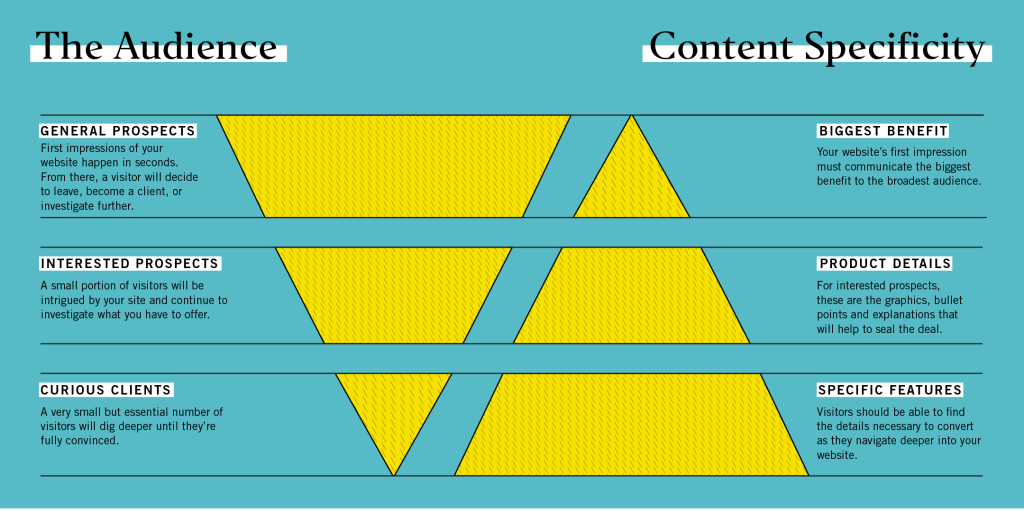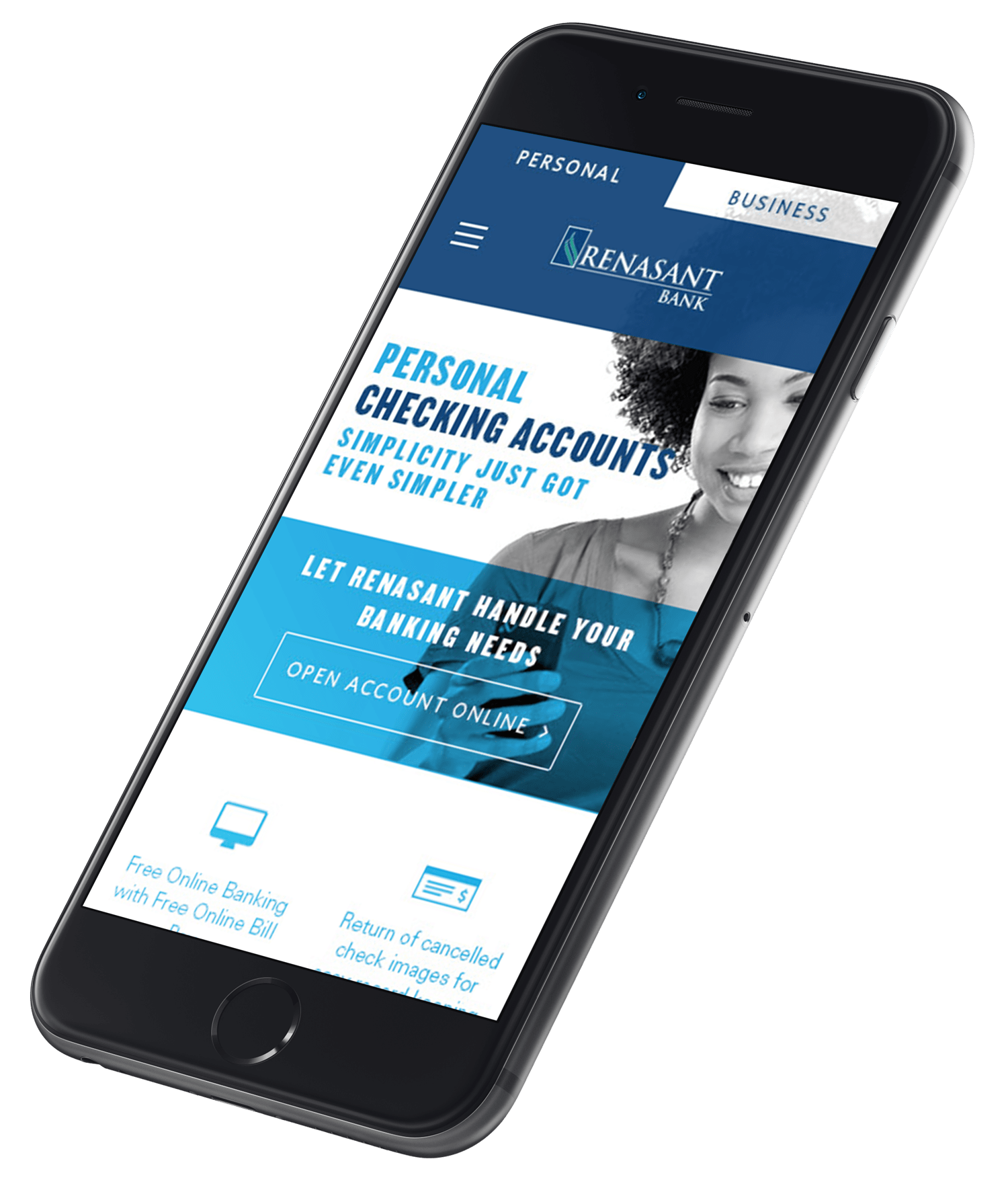The Inverse Triangles of Content
The term “content” is thrown around a little too loosely and generically.
Imagine for a moment you’re single, looking to go on a date.
You’re grocery shopping and you meet someone who perfectly matches any superficial parameters you might have.
He/she notices you noticing him/her and seems interested.
You work up your courage, walk over, and say…
“Will you marry me?” Then you spend the next two to three hours relating your deepest, darkest secrets.
Totally inappropriate, right? (Hopefully, you agree. Otherwise, this isn’t the blog for you.)
So, why then, when we’re writing copy for our banks, do we try to dump all the information we can on a viewer of our ads or visitor to our website?
It’s a tendency that seems a bit more natural when you have this mindset:
“They showed interest!
“This is our only chance!
“Show it ALL to them!
“We won’t get another chance!”
Much like the earlier, hyperbolic example, the “interested party” probably won’t stick around for long.
There is an appropriate order to conversation. A deep understanding of this order can help you create more engaging content that draws in people instead of running them off.
A few years back, I created the Inverse Triangles of content:

The triangle on the left is a standard visitor funnel. It assumes that you will experience a drop-off in traffic as visitors dig deeper into your materials. But that’s not the whole story. My personal breakthrough came when I began comparing content to visitor drop-off. The depth and breadth of content is represented by the triangle on the right.
As I teach this to my staff, I break both triangles into three levels. You might have many more than three levels, but let’s stick with that. Also, for clarity, let’s use your website as an example. But this can apply to ad copy, videos, or almost any content with which you intend to engage an audience.
Level One
This is your website’s home page or a landing page. It’s the first engagement point with a visitor. It’s also where most of your traffic will occur, thus represented by the largest area of the visitor triangle. But it’s the smallest area of the content triangle. That’s because this is the most superficial area. This is where a visitor’s gut-check kicks in:
“Does this place look reputable?”
“Does this look like a bank with which I would do business?”
“Are these the products/services I’m looking for?”
“Am I even on the correct site?” (This is particularly true if you aren’t diligent about brand consistency from ads to web.)
Just like in any form of attraction, there are superficial cues—sometimes conscious, other times subconscious—that give us an internal green light (Go! Go! Go!) or red light (Hold up!).
You should always strive to make your top-level content engaging to a wide audience, but you must also understand that not everyone will dig deeper. You can’t be everything to everyone. But don’t get sad. It’s not a true loss. If you gave the visitor compelling content and a path to dig deeper, you will only lose those who were nothing more than superficially interested (more on those folks later) to begin with.
Level Two
This is the middle ground. It’s the product page or checking account comparison page. If there’s a formal theory around the Inverse Triangles, it would be stated like this: As a group of people seeks more information, the audience will shrink, and it will want information in greater quantity, depth, and detail.
Your superficial visitors aren’t interested in the granular details of each and every checking account. But some of that top-level audience is. The trouble is you can’t tell which visitor is which. You must give everyone a chance to determine if your information resonates with them, provide a path to continue to learn, and continue to give relevant information at the next level.
You can assume that those who click the “Learn More” button want to learn more. Staging information in this way not only makes a better user experience and customer journey, but it also frees up space to organize information better.
Level Three
Only the most interested and detail-seeking folks will make it here. But you have to give them a destination, as these people might become some of your most dedicated clients.
Also, keep in mind, you’re not hiding information. You’re organizing it. There are folks who’re ready to sign up for that new checking account on level one. Don’t hinder them by forcing them to muck through deep information that doesn’t interest them. Give them easy access to the Apply Now button.
Similarly, don’t make it difficult for the person who wants to read the fine print to find it. It’s appropriate to put that deep level of detail under more superficial information.
Your website, ads, etc. are yours. It’s up to you to make a better user flow even if that means creating new content and new paths from scratch. And again, it’s all about organization.
Organization
The example deals with the way content flows from page to subpage. This lesson also applies to vertical space in an individual webpage or ad (which is why you always see disclaimers at the bottom).
The readers’ knowledge grows as they travel the path you set. They’re ready for more in-depth information because of the foundation you set earlier.
Keep in mind, that information can (and many times should) grow in volume further down the trail.
As important as it is to organize the data, I can’t reiterate enough that you’re providing paths. Just as you’re providing a path to go deeper, you must also provide a path to engage/convert. Make certain that you provide the visitor ways to easily sign up for services when they’re ready. Provide multiple ways to convert at each step—even risking overkill. Because, in the end, all of this is about providing a more comprehensive environment for your audience to find the comfort needed to do business with you.
Compliance
Be sure to have your internal compliance department review your flow. Your team may be a bit more conservative in approach, and prefer to not separate certain components or details. You may also have to add disclaimers to each page that describe the product—which is fine, as long as the page is laid out properly.
Revisit the Superficially Interested
I hope you didn’t forget about those superficially interested visitors who chose to leave your page. I didn’t.
Never discount the amount of budget required to generate visitors and never forget that most visitors aren’t convinced on the first pass. At the very least, you must implement a retargeting campaign to serve ads that acknowledge and follow that visitors who were distracted by a Facebook notification and forgot they went to your website in the first place. Beyond that, you can consider building true lead capture efforts around marketing automation and other emailing platforms.
The short version: you’re wasting money if you attract people to your website and forget about those who don’t convert on the first try.
Set the Stage
You don’t have to rewrite your entire website tomorrow. But now that you know about the Inverse Triangles of Content, you do have to start somewhere. Start with an easy win.
- Choose one high-traffic area of your website, such as checking, and plan out the stages that will draw visitors deeper into the product offering.
- Make certain you serve the content they need as they go deeper.
- Give visitors many ways to convert at any step along the way.
- Now you’re ready to build more engaging content across all media.




